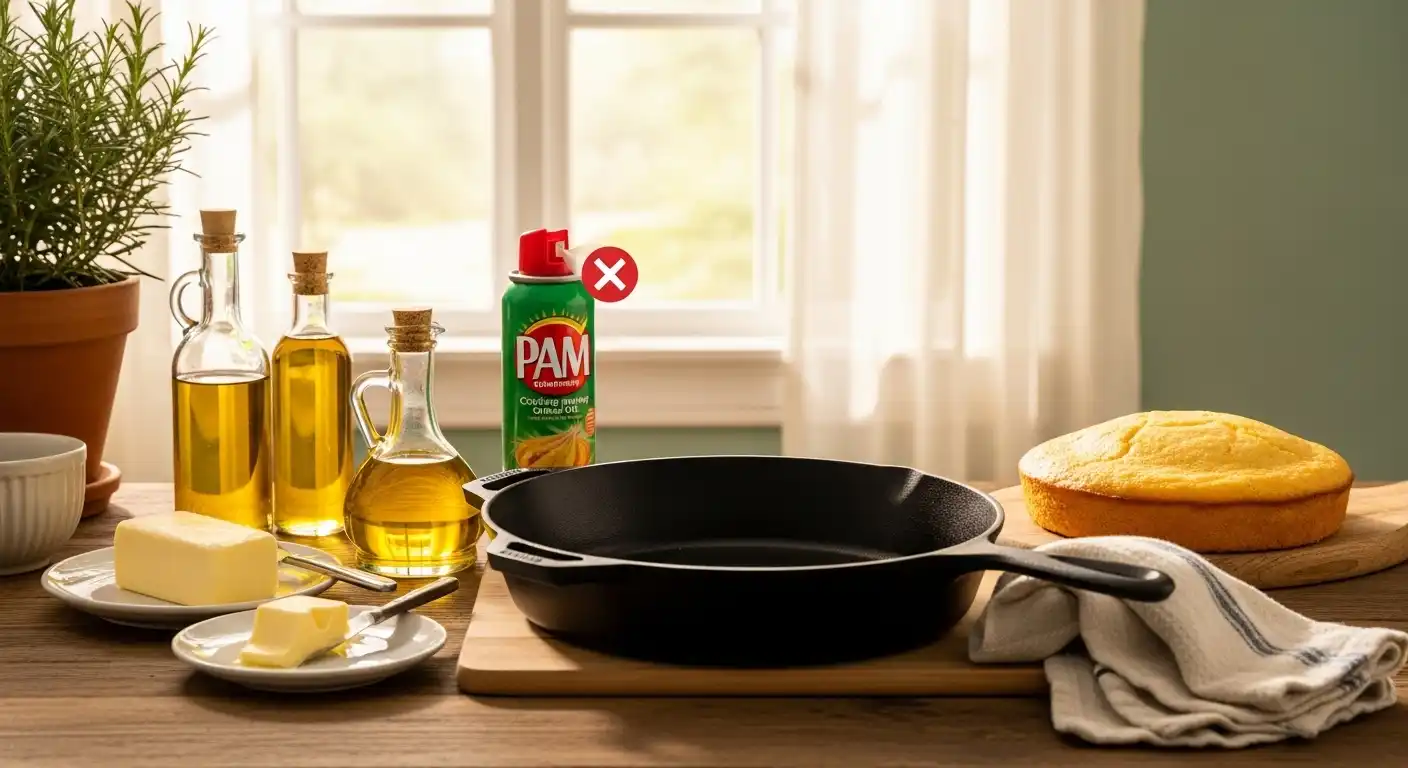Can You Spray a Cast Iron Skillet with Pam?

Cast iron skillets are beloved for their durability, versatility, and ability to create perfectly seared dishes.
However, their care can spark debates among home cooks. One question that frequently arises is: Can you spray a cast iron skillet with Pam?
This blog post dives into the nuances of using cooking sprays like Pam on cast iron, exploring the impact on seasoning, performance, and maintenance.
Understanding Cast Iron Seasoning
The magic of a cast iron skillet lies in its seasoning—a layer of polymerized oil that creates a non-stick surface.
🎃 Spooky Good Amazon Deals This Fall !
From cozy fall essentials to Halloween must-haves, shop Amazon’s seasonal discounts now. Don’t wait, deals vanish fast!
*As an Amazon Associate, I earn from qualifying purchases.

This seasoning develops over time through cooking with fats and proper care.
Using a cooking spray like Pam, which contains propellants and additives, can interfere with this process.
The question isn’t just about convenience but about preserving the skillet’s unique qualities.
Maintaining that seasoning requires careful consideration of what touches the pan.
Let’s explore whether Pam is a friend or foe to your cast iron.
Can You Spray a Cast Iron Skillet with Pam? The Short Answer
Technically, you can spray Pam or similar aerosol cooking sprays on a cast iron skillet, but it’s not recommended.
The additives in these sprays, such as soy lecithin or propellants, can leave a sticky residue that disrupts the skillet’s seasoning.
This residue can build up over time, creating a gummy layer that’s tough to clean without stripping the seasoning.
Instead, traditional fats like vegetable oil or butter are better choices for cooking with cast iron.
Why Cooking Sprays Like Pam Cause Issues
Pam and other aerosol sprays are formulated for convenience, but their ingredients can harm cast iron.
Propellants, emulsifiers, and anti-foaming agents don’t bond well with the skillet’s surface.
Over time, these additives can create a tacky coating that attracts food particles and burns unevenly.
🎃 Spooky Good Amazon Deals This Fall !
From cozy fall essentials to Halloween must-haves, shop Amazon’s seasonal discounts now. Don’t wait, deals vanish fast!
*As an Amazon Associate, I earn from qualifying purchases.
This compromises the non-stick properties that make cast iron so appealing.
For those who love using their cast iron skillet on an induction cooktop, maintaining a clean seasoning layer is even more critical to ensure consistent heat distribution.
The Best Oils for Cast Iron Cooking
Instead of Pam, opt for oils with high smoke points that enhance seasoning.

Vegetable oil, grapeseed oil, or flaxseed oil are excellent choices for cooking and maintaining your skillet.
These oils polymerize effectively when heated, reinforcing the non-stick layer.
A thin coat applied before cooking ensures food releases easily without sticky residues.
If you’re new to cast iron, check out our guide on how to use a pre-seasoned cast iron skillet for the first time for tips on building that perfect seasoning.
How to Apply Oil to Your Cast Iron Skillet
Applying oil to a cast iron skillet is simple but requires care.
Use a paper towel to spread a thin layer of oil across the cooking surface before heating.
Avoid pooling oil, as excess can lead to uneven seasoning or stickiness.
Heat the skillet gently to let the oil bond with the surface.
This method ensures a smooth, durable seasoning layer, unlike the residue left by sprays like Pam.
🎃 Spooky Good Amazon Deals This Fall !
From cozy fall essentials to Halloween must-haves, shop Amazon’s seasonal discounts now. Don’t wait, deals vanish fast!
*As an Amazon Associate, I earn from qualifying purchases.
Cleaning Your Cast Iron After Cooking

Proper cleaning is key to maintaining your skillet’s seasoning.
After cooking, scrape off food residue with a spatula or brush while the pan is still warm.
Use hot water and a non-metal scrubber to clean without soap, which can strip seasoning.
Dry thoroughly to prevent rust, then apply a light oil coating.
For tougher messes, our guide on how to clean a cast iron wok offers techniques that apply to skillets too.
Common Misconceptions About Cast Iron Care
Many believe cast iron is high-maintenance, but it’s quite forgiving with the right approach.
One myth is that any oil or spray works for cooking or seasoning.
Sprays like Pam can seem like a quick fix, but they often do more harm than good.
Stick to natural oils to keep your skillet in top shape.
Another misconception is that cast iron can’t handle modern cooking methods.
🎃 Spooky Good Amazon Deals This Fall !
From cozy fall essentials to Halloween must-haves, shop Amazon’s seasonal discounts now. Don’t wait, deals vanish fast!
*As an Amazon Associate, I earn from qualifying purchases.
In fact, you can safely use your skillet in the oven or on a glass-top stove with proper care.
When Cooking Sprays Might Be Tempting
Cooking sprays are popular for their ease of use, especially for low-fat cooking or quick prep.
However, cast iron thrives on traditional fats that enhance its seasoning.
If you’re looking to reduce oil use, try brushing on a thin layer of oil instead of spraying.
This gives you control without the additives.
For alternative cookware that handles sprays better, explore what can you use instead of a cast iron skillet.
Long-Term Effects of Using Pam on Cast Iron
Repeated use of Pam can lead to a buildup that’s difficult to remove without aggressive cleaning, which risks damaging the seasoning.
This can make your skillet less effective over time.
In severe cases, you may need to strip and re-season the pan, a process that’s time-consuming but restores its non-stick glory.
To avoid this, use oils that complement the skillet’s natural properties, ensuring longevity and performance.
Tips for Maintaining Your Cast Iron Skillet
To keep your cast iron skillet performing at its best, follow these tips:
- Season regularly: Apply a thin layer of oil after each use to maintain the seasoning.
- Store properly: Keep your skillet dry and in a well-ventilated area to prevent rust. Learn more in our guide on how to store food in cast iron cookware.
- Avoid harsh cleaners: Skip soaps and abrasive scrubbers to preserve the seasoning.
These habits ensure your skillet remains a kitchen workhorse for years.
🎃 Spooky Good Amazon Deals This Fall !
From cozy fall essentials to Halloween must-haves, shop Amazon’s seasonal discounts now. Don’t wait, deals vanish fast!
*As an Amazon Associate, I earn from qualifying purchases.
Can You Use Pam in Other Cast Iron Cookware?
The concerns about Pam extend to other cast iron cookware, like Dutch ovens or woks.
For example, seasoning a cast iron Dutch oven follows similar principles, and sprays should be avoided.
If you’re using a Lodge cast iron wok, stick to oils to maintain its seasoning and avoid sticky buildup.
When to Re-Season Your Cast Iron Skillet
If your skillet develops sticky spots or loses its non-stick quality, it may need re-seasoning.
This involves cleaning the pan thoroughly, applying oil, and baking it to rebuild the seasoning layer.
Check out our guide on how often to replace a cast iron skillet to understand when re-seasoning versus replacement makes sense.
Regular maintenance reduces the need for frequent re-seasoning, keeping your skillet ready for action.
Cooking Safely with Cast Iron
Cast iron is incredibly versatile, but it’s not suitable for every cooking method.
For instance, avoid using it in a microwave, as explained in our post on can you use a cast iron skillet in a microwave.
Similarly, be cautious about storing acidic foods in cast iron, as outlined in our guide on can you put cast iron in the fridge.
Using the right techniques ensures your skillet stays safe and effective.
Why Cast Iron Enthusiasts Avoid Cooking Sprays
Cast iron enthusiasts are passionate about preserving their pans’ heritage and performance.
Cooking sprays like Pam are often seen as a shortcut that undermines the skillet’s natural qualities.
By sticking to traditional oils, you honor the legacy of cast iron while ensuring optimal cooking results.
For those curious about skillet history, our post on how to tell how old is a cast iron skillet offers fascinating insights.
Alternatives to Pam for Non-Stick Cooking
If you’re hesitant to use more oil, consider these alternatives for non-stick cooking in cast iron:
- Butter: Adds flavor and works well for low-heat cooking.
- Lard or bacon grease: Traditional fats that enhance seasoning.
- Clarified butter (ghee): High smoke point and rich flavor.
These options maintain the skillet’s seasoning while delivering great results.
Final Thoughts on Spraying Pam in Cast Iron
So, can you spray a cast iron skillet with Pam?
While it’s technically possible, it’s not the best choice for maintaining your skillet’s seasoning and performance. Stick to natural oils to keep your cast iron in top condition.
With proper care, your skillet can last a lifetime, delivering delicious meals and a satisfying cooking experience.
Explore more cast iron tips, like how to reduce smoke when cooking with cast iron, to elevate your skills and keep your kitchen running smoothly.
